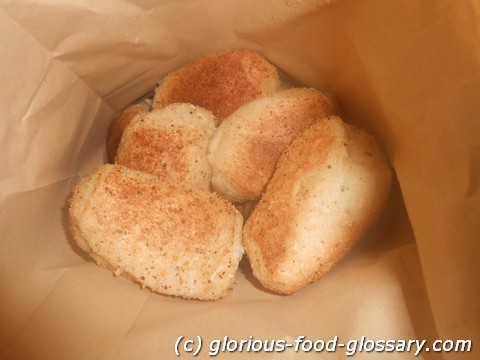Deutsch: Malunggay-Brötchen / Español: Pan de sal con malunggay / Português: Pão de sal com malunggay / Français: Pain au sel et malunggay / Italiano: Pane al sale con malunggay
Malunggay Pandesal in the food context refers to a variation of the traditional Filipino bread roll known as pandesal, which is enhanced with malunggay (Moringa oleifera) leaves. Malunggay, also known as moringa, is a plant native to parts of Africa and Asia, known for its highly nutritious leaves that are rich in vitamins, minerals, and antioxidants. Incorporating malunggay into pandesal not only boosts the nutritional value of the bread but also adds a subtle green hue and a slight, earthy flavor to the rolls.
Description
Pandesal is a staple bread in the Philippines, typically enjoyed for breakfast or as a snack, often served with butter, cheese, or jam. By adding malunggay leaves to the dough, bakers create a more nutritious version of this beloved bread, aligning with the growing interest in healthful eating. Malunggay Pandesal can be found in bakeries and markets throughout the Philippines, offering a delicious way to consume the beneficial nutrients of malunggay.
Application Areas
Malunggay Pandesal is enjoyed in a variety of settings, including:
- Breakfast: Commonly consumed in the morning, paired with coffee or hot chocolate.
- Snacks: A healthy option for midday or afternoon snacks, often filled with savory or sweet spreads.
- Health and Wellness: Sought after by individuals looking to incorporate more nutrient-dense foods into their diets.
Well-Known Examples
While Malunggay Pandesal itself is a specific item, it belongs to a broader category of foods enriched with malunggay, including:
- Malunggay Smoothies: Beverages made by blending malunggay leaves with fruits and vegetables.
- Malunggay Omelettes: Eggs cooked with malunggay leaves and other ingredients.
- Malunggay Soup: Soups and broths fortified with malunggay leaves for added nutrition.
Recipes
A basic recipe for making Malunggay Pandesal involves:
-
Ingredients:
-
Preparation:
- In a large bowl, combine the flour, yeast, sugar, and salt.
- Add the warm milk, melted butter, and egg to the dry ingredients and mix until a dough forms.
- Fold in the finely chopped malunggay leaves.
- Knead the dough on a floured surface until smooth and elastic.
- Place the dough in a greased bowl, cover, and let it rise until doubled in size, about 1 to 2 hours.
- Punch down the dough, divide it into small portions, and roll each portion in breadcrumbs.
- Place the dough portions on a baking sheet, cover, and let them rise again for about 30 minutes.
- Bake in a preheated oven at 350°F (175°C) for 20 to 25 minutes, or until golden brown.
- Serve warm or at room temperature.
Treatment and Risks
Malunggay Pandesal is generally considered healthy and safe for consumption. However, as with any food, it's essential to ensure that malunggay leaves are clean and free from contaminants before adding them to the dough. For those with specific dietary restrictions or allergies, ingredients in the recipe may need to be adjusted accordingly.
Similar Terms or Synonyms
- Moringa Bread Rolls
- Nutritious Pandesal
Summary
Malunggay Pandesal is a nutritious twist on the traditional Filipino bread roll, incorporating the health benefits of malunggay leaves into a beloved culinary staple. This variation not only adds a unique flavor to the pandesal but also enhances its nutritional profile, making it a popular choice among health-conscious consumers and those looking to enjoy a delicious, healthful bread option.
--


